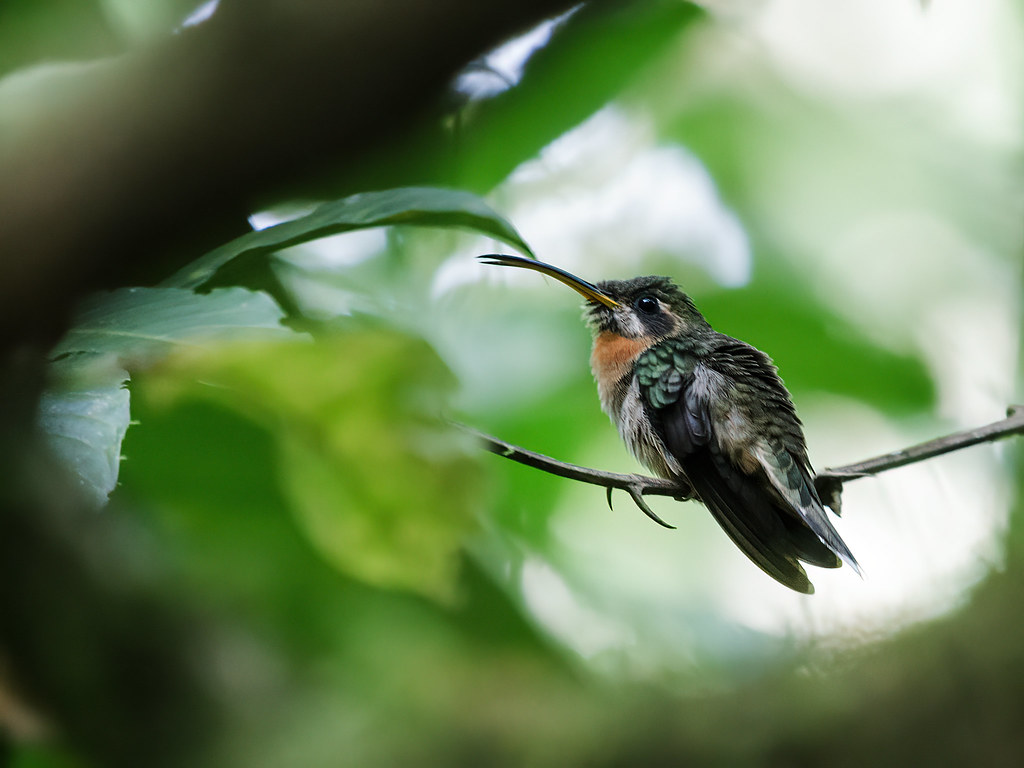IDENTIFICATION: The Band-tailed Barbthroat (Threnetes ruckeri) takes its name from its striking black-and-white tail pattern and the dusky, bristly feathers of its chin and upper throat. The sexes are similar, though adult males have straighter bills and slightly brighter, more contrasting plumage than females. While tail spread, white base sawed with black and white tips.
DISTRIBUTION & SUB-SPECIES: There are three subspecies, varying slightly in plumage coloration and range. This hummingbird forages for nectar by traplining, frequently “robbing” from long-flowered Heliconia species, and Calathea by piercing the bases of the corollas. As with other barbthroats, spiders are among their favorite prey.
Males display on low perches in the undergrowth, alone or in loose groups, singing shrill, squeaky songs while bobbing their tails. The medium-sized hummingbird resident to Subsp. ruckeri occurs in northern and western Colombia and western Ecuador; subsp. venezuelensis occurs in northwestern Venezuela; it’s got duller breasts compared to nominate northern race. Also, subsp. ventosus ranges from Southeastern Guatemala, Belize, and Panama.
HABITAT: Band-tailed Barbthroat inhabits the shady understory and edges of primary and disturbed lowland humid evergreen forest, older secondary growth, shrubbery, Heliconia thickets, and banana plantations; 0–3,950 ft (0– 1,200 m). However, chicks may wander higher.
NEST: The nest is a deep, untidy-looking cup attached to the underside of a large leaf such as Heliconia, palm, or banana. Female hummingbird put their efforts into making cup-shaped nests, with plant fibers two to four meters high on the underside of a Heliconia and often at the banana leaf. (The Male bird does not participate in selecting the site, raising the chicks, or even building the nest).
Normally, the clutch contains two white eggs, which are female, to incubate alone. During the incubation period, males protect the territory and feed the nectar of the flowers. The baby bird was born blind, but, like adults, has buff feather tips. The chicks leave the nest in two and half weeks. Male birds mate with many females, and similarly, females mate with many males.
SIZE: The average size of band-tailed barbthroat is about 10–11 cm.
SONG, CALL, AND SOUNDS: This curved bill hummingbird has a high, thin tseep call, alone or a lek, (competitive mating display), which is a didiDIT dew dew, but sometimes the sound is a bit longer, consisting of trills and warblers.
DIET: Band-tailed Barbthroat feeds consist of nectar whipping away with a sharp buzzy squeak, catching insects in the midair, Heliconia, bananas, and Costus.
WEIGHT: The average weight is about 5–7 grams.
STATUS The population is large (not known); hence, does not approach the threshold for vulnerability. Therefore, this hummingbird is evaluated as Least concerning.
OTHER NAMES:
- German: Weißbinden-Schattenkolibri
- Spanish: Ermitaño Barbudo Colibandeado
- French: Ermite de Rucker
- Italian: Barbuto codafasciata
- Dutch: Bandstaartbaardkolibrie
- Swedish: bandstjärtad erem
- Turkish: Bant kuyruklu sakallı hermit
Read More: White-tufted Sunbeam

Band-tailed Barbthroat takes its name from its striking black-and-white tail pattern & dusky, bristly feathers of its chin and upper throat. Photo Credit: Nick Athanas







